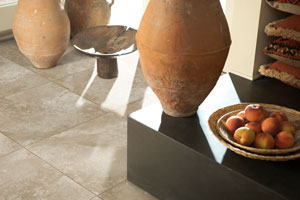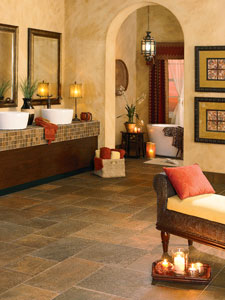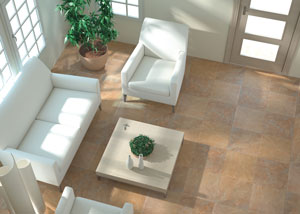 It is more than a coincidence: Consumer confidence is on the rise and ceramic tile manufacturers saw some of their highest numbers in the second quarter that they had in the last several years. Though the ice hasn’t frozen solid, the category has shown more than just stability with an increase in units sold.
It is more than a coincidence: Consumer confidence is on the rise and ceramic tile manufacturers saw some of their highest numbers in the second quarter that they had in the last several years. Though the ice hasn’t frozen solid, the category has shown more than just stability with an increase in units sold.
No one denies the category took a hit when the housing market crumbled, but consumers seem to be back in the market for ceramic tile. “Both business segments have been impacted over the last couple of years, but as they rebound the future is bright,” said Kim Holm, president, Mannington Residential. “New technologies have opened the door for tremendous growth opportunities in the category.”
What is today’s market size?
When it comes to judging how much ceramic takes in market share, opinions vary from each manufacturer. Some are erring on the side of caution, uncertain of where to peg the ceramic category. “We have been on a roller coaster ride for the last several years, so it is hard to get a handle on where we are as an industry,” said Jason Kyzer, Shaw’s product category manager for tile and stone.
The housing market’s collapse—the most popular area for tile consumption—especially in the Southwest, has undoubtedly slowed ceramic buying. One would be hard pressed to find dissenters with the assertion that residential building is essentially stagnant, according to Donato Grosser, consultant, Ceramic Tiles of Italy.
The Tile Council of North America (TCNA) stated total U.S. ceramic tile consumption in the first quarter of this year was at 492 million square feet, up 23.1% versus the same period last year, which made up only 400 million square feet. This came as a welcome change. “U.S. tile consumption declined for three years in a row from 2006 to 2009,” said Andrew Whitmire, trade data analyst, TCNA. “This is the first time this has occurred since 1982 during the midst of the last major recession.”
Last year’s numbers were quite a “roller coaster” ride. The second quarter jumped up to 492 million square feet and continued rising before dipping to its yearly low of 469 million square feet in the fourth quarter. However, TCNA officials are not discouraged when projecting for the remainder of the year.
“Based on the information we have to date, I think it’s very likely we’ll see our first year- over-year increase in consumption since 2005/2006,” Whitmire said. “A lot depends on the housing market and employment situation.”
The first half of the year
The first half of 2010 was a positive change for the ceramic category—both in terms of change over the same period last year and fiscal growth. For example,  Tiles of Spain reported a 10% increase in both dollars and units compared to 2009, said Rocamador Rubio, director.
Tiles of Spain reported a 10% increase in both dollars and units compared to 2009, said Rocamador Rubio, director.
Ceramic Tiles of Italy also reported very positive numbers with a 21.5% increase over 2009’s first quarter U.S. shipments and imports. Though any growth is a welcome change, the category is not what it once was. “With construction at a standstill, the ceramic segment has experienced a drop,” Grosser said. “People are finishing up projects from one or two years ago, but ceramic tile in the U.S. is back to what it was 10 years ago.”
Shaw also had positive reports, noting the first half of the year was better than expected due in large part to the homebuyer tax credit and general optimism. “It was a breath of fresh air, but I don’t think anyone really thinks we are out of the dark yet,” Kyzer said.
Dollars vs. units
There is good news to be heard when it comes to ceramic sales. Most manufacturers reported unit sales are up with Mannington reporting an increase of 7.1%, according to Holm.
Similarly, Tiles of Spain cited a significant increase over 2009 at 10%, with product innovation as the driving force for American consumption of Spanish tile. “There is an increased interest by consumers in using wood and wood byproduct material in rooms traditionally using ceramic tile,” Rubio explained. “Spain is addressing this interest by creating wood plank looks in a variety of ‘species,’ lengths and widths to offer the look Americans want with the performance ceramic offers.”
Though the dollars do not directly reflect the increase in units sold, there has been no decrease. This is due largely in part to stability in product pricing, which is also a common claim among suppliers. “There seems to be a lot more stability in pricing in the last few months, though we have seen some erratic pockets of pricing in certain markets,” Kyzer said. “We knew the average prices were going to be depressed in the foreseeable future. It is a fact of the times.”
To combat this, Shaw plans to make long-term decisions that support the outcome and profitability of the category.
Florida Tile also reported consistent average sales pricing. “We have an established customer base that is committed to us,” said Sean Cilona, director of marketing. “Anything we do to promote sales is usually through expansion of market share or other incentives to those current customers.”
Current trends
 Today’s looks are driven by technology that affords levels of realism on par with the materials being recreated. “Given the amazing capabilities of inkjet printing, we are able to create any pattern we want,” Cilona said. “This is definitely influencing the resurgence of stone looks [though] I don’t think there has been any huge change over the past few years in terms of the size of products aside from the popularity of rectangular formats.”
Today’s looks are driven by technology that affords levels of realism on par with the materials being recreated. “Given the amazing capabilities of inkjet printing, we are able to create any pattern we want,” Cilona said. “This is definitely influencing the resurgence of stone looks [though] I don’t think there has been any huge change over the past few years in terms of the size of products aside from the popularity of rectangular formats.”
American Marazzi also reported inkjet printing as the overarching trend in more than just stone looks. “Fabrics, natural stone looks and woods are currently strong influences as consumers seek respite from harsh economic realities in tranquil, spa-like surroundings,” said Hector Narvaez, executive vice president for sales and marketing.
Mohawk Hard Surfaces also noted printing processes have advanced the category, particularly on large-format sizes like 20 x 20 and 24 x 24.
“The realism of products continues to improve as suppliers all over the world produce products with digital printing technology,” Farabee said. “Over time, prices for products made with digital printing technology will decline.”
What advanced technology represents for ceramic right now is value, and combining realistic, unique looks with one of the hardest flooring materials on the market achieves that. “We continue to see home owners, purchasers and end users shying away from upgrades and higher-end products for those that have the color and visual that ‘gets the job done’ at an economical price,” Kyzer said. A lift out of the depressed economy will not change that idea either; the new consumer has changed her spending habits and is unlikely to buy frivolously any time in the future.
A look into the future
Though American Marazzi reported a rebound in orders for the first half of the year, activity seems to be slowing down. “Unfortunately, we think most of that material was not sold down the supply chain and we have noticed a slower pace than the first semester,” Narvaez said. Stocking product may be a positive in the long-term recovery. Mannington anticipates that as the market rebounds, domestic service and inventory is a must for future success in the tile category, Holm said.
Looking further into the future, economic indicators point to stronger recovery in 2011, Farabee said. “We are expecting ceramic industry growth to resume next year in the mid-to-high single-digit range.”
This is dependent upon the strengthening of fiscal fundamentals, he added, including, but not limited to, gross domestic product, employment growth and improved consumer confidence.
Confident buyers are also essential for Florida Tile. “I don’t think growth will be consistently positive [until] people deal with their fears of investing,” Cilona said. “I believe we are seeing a very slow increase in sales and we will continue to see this slow climb back to normalcy, not in excess like we had in the middle of the decade, but acceptable.”
TCNA also sees conditions lined up in favor of a solid rebound, with the GDP increasing for the last four consecutive quarters and the lowest annual fixed mortgage rates on record. “Driven by extended tax credits and these historically low mortgage rates, many economists expect to see an increase in new home starts this year,” Whitemire said.
-Emily Hooper
